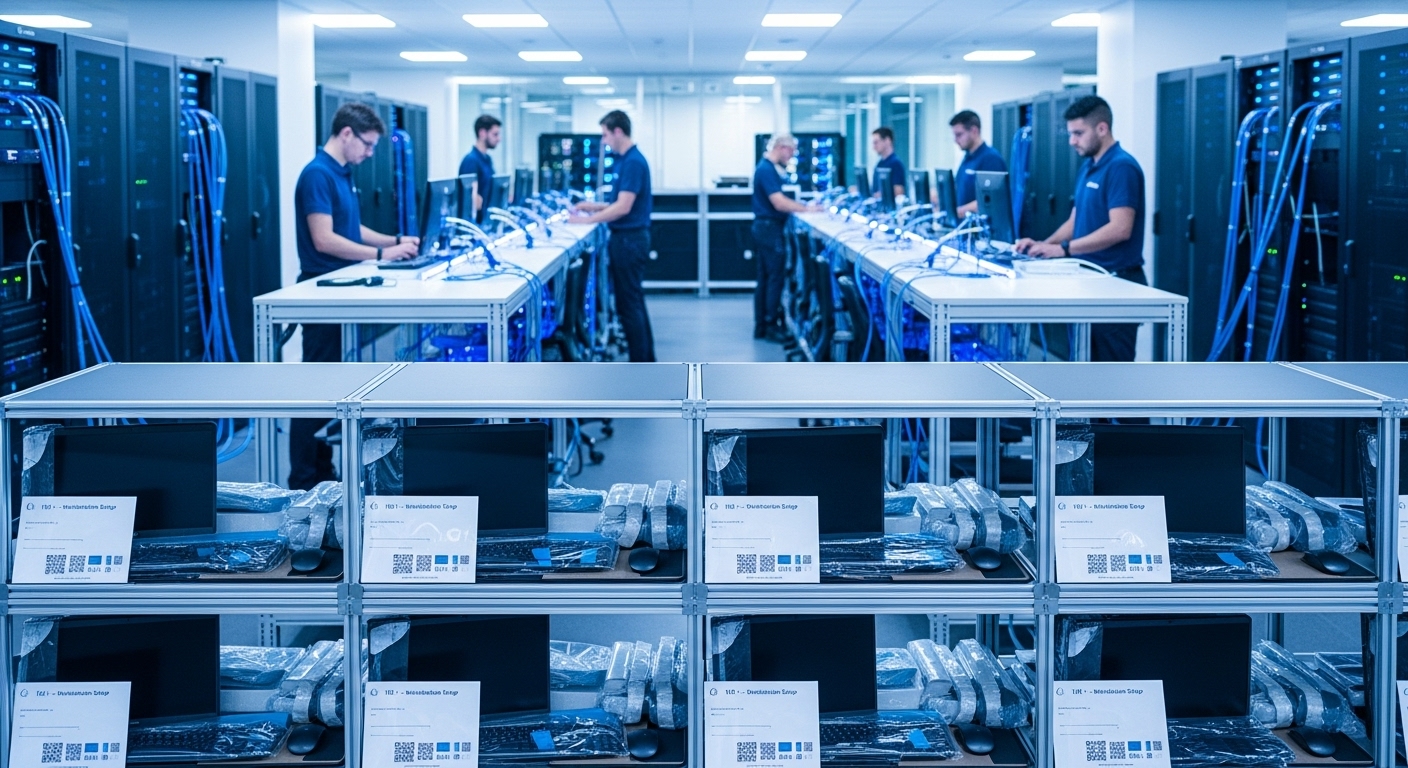In today’s hyper-connected business landscape, IT downtime is no longer a minor inconvenience; it’s a critical failure with catastrophic financial and reputational consequences. For any organization, from a burgeoning startup to an established enterprise, the IT infrastructure is the central nervous system, powering every transaction, communication, and innovation. Yet, too often, IT setup is treated as a logistical afterthought, especially during an office move or expansion. Recent search trends show a growing demand for proactive, strategic IT planning that prevents problems before they start. This guide, The Resilience Roadmap, reframes the conversation. It’s not just about plugging in computers; it’s about architecting a scalable, secure, and resilient digital foundation designed for zero downtime. We will walk through the essential stages, from initial strategic planning and core network design to choosing your data model, embedding security, and ensuring business continuity, providing a blueprint to transform your IT from a cost center into a strategic asset for unstoppable growth.
The Foundational Blueprint: Strategic IT Infrastructure Planning
The first step in building a resilient IT infrastructure is to resist the urge to immediately purchase hardware. The most critical work is done in the strategic planning phase, long before a single cable is run. This blueprint phase is about aligning technology with business objectives. Start with a comprehensive needs assessment. This involves more than just counting current employees; it requires forecasting future growth, understanding the software and applications the business relies on, and projecting data storage requirements for the next three to five years. A key decision at this stage is navigating the financial models of Capital Expenditure (CapEx) versus Operational Expenditure (OpEx). Buying on-premise servers is a traditional CapEx investment, while subscribing to cloud services falls under OpEx. Your choice will have long-term implications for your budget, scalability, and accounting. A recent report from Gartner highlights a significant shift towards OpEx models for greater flexibility.
“By 2025, 55% of all data center infrastructure spending will shift to As-a-Service consumption models, up from 15% in 2022.”
This underscores the importance of a forward-looking financial strategy. The most crucial element of this phase is ensuring that IT leadership is involved in every conversation about office design, logistics, and expansion from day one. Integrating IT planning with architectural and logistical planning prevents costly retrofits and ensures the physical space can support the technological demands, from server room HVAC requirements to power distribution.
Designing the Network Core: Cabling, Connectivity, and Hardware
With a strategic plan in place, the next layer is designing the physical network core—the literal and figurative wiring of your organization. The quality of your structured cabling system is a primary determinant of network speed and reliability. The current standard is Category 6A (CAT 6A) cabling, which supports 10 Gigabit Ethernet speeds and is a wise investment for future-proofing your network. The physical layout of this cabling must be meticulously planned in conjunction with the office floor plan, ensuring data ports are accessible where needed and that cable runs are protected and organized. This avoids the dreaded ‘spaghetti’ of wires that is both a maintenance nightmare and a performance risk. At the heart of the network are your core hardware components: routers, switches, and firewalls. Selecting enterprise-grade hardware from reputable vendors is non-negotiable for resilience. Routers direct traffic between networks, switches connect devices within a network, and a Next-Generation Firewall (NGFW) acts as the primary security gatekeeper. A critical design principle for resilience is network segmentation. This practice involves dividing your network into smaller, isolated sub-networks. For example, guest Wi-Fi should be completely separate from the internal corporate network, and sensitive departments like finance or HR can have their own segmented network to contain potential breaches. Finally, planning for robust wireless coverage with modern standards like Wi-Fi 6 or Wi-Fi 6E is essential for mobility and supporting the high density of devices in a modern workplace.
The Data Dilemma: Choosing Between On-Premise, Cloud, and Hybrid Models
One of the most significant architectural decisions you will make is where your data and applications will live. The choice between on-premise servers, a full cloud deployment, or a hybrid model has profound effects on cost, security, performance, and scalability. An on-premise data center gives you complete physical control over your data, which can be a requirement for organizations with strict compliance mandates (e.g., healthcare with HIPAA or finance with PCI DSS) or those running legacy applications not suited for the cloud. However, it also comes with a high upfront cost, ongoing maintenance overhead, and challenges in rapid scaling. Conversely, a full-cloud model with an Infrastructure as a Service (IaaS) provider like AWS, Google Cloud, or Microsoft Azure offloads all hardware management and offers unparalleled scalability and flexibility. You pay for what you use, converting a large capital expense into a predictable operating expense. The downside can be potentially higher long-term costs and less control over the underlying infrastructure. For many businesses, a hybrid model offers the best of both worlds. This approach allows you to keep sensitive data or latency-sensitive applications on-premise while leveraging the cloud’s power for scalable applications, data backup, and disaster recovery. The decision framework should be based on a careful analysis of your specific needs: regulatory requirements, application performance, team skillset, and long-term business trajectory.
Layered Defenses: Integrating Cybersecurity from the Ground Up
In the modern era of persistent cyber threats, security cannot be an add-on; it must be woven into the very fabric of your IT infrastructure from the initial design. A resilient system is a secure system. This starts with physical security. Your server room or data closet must be a fortress with controlled access (keycard, biometrics), proper climate control to prevent hardware failure, and robust fire suppression systems. Moving to the digital realm, your Next-Generation Firewall (NGFW) is the first line of defense, but it’s not enough. A layered security strategy, often called ‘defense-in-depth,’ is essential. This includes deploying Intrusion Detection and Prevention Systems (IDS/IPS) to monitor network traffic for malicious activity. Endpoint security is also critical; every device connecting to your network (desktops, laptops, mobile phones) must be protected with advanced anti-malware and Endpoint Detection and Response (EDR) software. A foundational security principle to integrate into your design is the Principle of Least Privilege. This means that any user, program, or process should only have the bare minimum permissions necessary to perform its function. This dramatically limits the potential damage a compromised account can cause. Implementing robust identity and access management (IAM) solutions, including multi-factor authentication (MFA), is a non-negotiable component of this strategy.
Ensuring Continuity: Redundancy, Backups, and Disaster Recovery
The promise of ‘zero downtime’ is achieved through a meticulous focus on business continuity. This requires building redundancy into every critical point of failure. At the most basic level, this means redundant power supplies in servers and network hardware, all connected to Uninterruptible Power Supplies (UPS) to handle short outages. For greater resilience, a natural gas or diesel generator can keep the entire operation online during extended power cuts. Network redundancy is equally important. This involves having two separate internet connections from two different providers to ensure you stay online if one goes down. Hardware redundancy can be achieved through techniques like RAID (Redundant Array of Independent Disks) for storage, which protects against disk failure, and server clustering, where multiple servers work together and can take over if one fails. Beyond redundancy is the critical function of backups. A robust backup strategy is your ultimate safety net. The industry-standard 3-2-1 rule is an excellent framework: keep at least three copies of your data, on two different types of media, with one copy stored off-site (or in the cloud). It is vital to distinguish between backups and a full Disaster Recovery (DR) plan. A DR plan is a comprehensive, documented policy that outlines how to restore your entire IT operation after a catastrophic event, and it must be tested regularly to ensure it works when you need it most.
Future-Proofing Your Foundation: Scalability and Vendor Management
The final pillar of the Resilience Roadmap is ensuring your infrastructure can evolve with your business without requiring a complete and costly overhaul. Future-proofing is about making smart choices today to accommodate the growth of tomorrow. When selecting hardware, whether it’s switches, servers, or storage arrays, choose models that have a clear path for expansion. This might mean a switch with extra ports that are currently unused or a server with empty drive bays and memory slots. Similarly, when choosing cloud services, ensure they can scale resources up or down on demand to match business cycles. One of the most overlooked aspects of future-proofing is documentation. Every aspect of your network design, hardware configuration, software licenses, and security policies must be thoroughly documented. This knowledge transfer is invaluable for troubleshooting, routine maintenance, and onboarding new IT staff. Finally, cultivate strong relationships with your technology vendors and partners. Don’t just focus on the initial purchase price. A reliable vendor provides excellent support, honors warranties, and acts as a strategic partner, offering insights into new technologies. Carefully negotiated Service Level Agreements (SLAs) with your internet service providers and critical software vendors are essential, as they legally define uptime guarantees and support response times, providing another layer of operational resilience.
Conclusion
Architecting a resilient and scalable IT infrastructure is one of the most impactful strategic investments a modern business can make. It transcends the technical details of cables and servers, forming the bedrock of operational continuity, innovation, and growth. By shifting the perspective from a reactive, break-fix mentality to a proactive, design-centric approach, you can build a system that not only supports your business today but is also prepared for the challenges and opportunities of tomorrow. The journey begins with a strategic blueprint that aligns technology with business goals. It’s fortified by a robust network core, a smart data strategy, and security layers that are integrated, not added on. True resilience—the ability to operate with zero downtime—is achieved through deliberate redundancy and a tested disaster recovery plan. Finally, by focusing on scalability and managing vendor relationships effectively, you create an agile foundation that can grow and adapt. Viewing your IT setup through this resilience roadmap ensures that your organization’s digital heart will beat strong, powering your success in an increasingly complex and unpredictable world. It’s not just about keeping the lights on; it’s about ensuring your future is bright.





